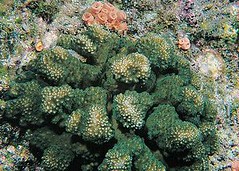 由於全球暖化、疾病以及海洋酸化,美國水域中有66種珊瑚礁瀕臨絕種。聯邦政府在11月30日提議,將66種珊瑚礁列入《瀕危物種法》(Endangered Species Act)保育類名單,加以保護。
由於全球暖化、疾病以及海洋酸化,美國水域中有66種珊瑚礁瀕臨絕種。聯邦政府在11月30日提議,將66種珊瑚礁列入《瀕危物種法》(Endangered Species Act)保育類名單,加以保護。
美國國家海洋暨大氣總署(NOAA)漁業部提案,將12種珊瑚列入瀕臨絕種(Endangered)、54種珊瑚列入受威脅(Threatened)。公告列管這些瀕臨絕種珊瑚的同時,捕魚與潛水等活動不受影響,然而對於這些物種的某些特定「行為」,諸如破壞、傷害、扼殺或是捕集,都列入禁止行為。會影響它們的商業活動,像是進口、出口,也列入禁止。
公告這份名單,也將帶動棲息地保護和復原計畫,並禁止聯邦政府任何可能使珊瑚陷入困境的作為。
2009年,民間智庫「生物多樣性中心」(Center for Biological Diversity)曾提出一項科學請願,為美國水域的83種珊瑚爭取聯邦政府的保護。此次提案為NOAA對請願作出的回應,但這83種珊瑚中有16種未獲聯邦採納。
「健康的珊瑚礁生長在地球上最具經濟價值且生物多樣性最高的生態系統,」NOAA署長盧布琴科博士(Jane Lubchenco)表示:「珊瑚提供了魚群棲息地,成為漁業、數以百萬計人口的食物來源;並透過休閒業、觀光業和漁業,為當地經濟體帶來了工作機會與收入;更在暴風雨與侵蝕作用之下保護了海岸線。然而,科學研究顯示,氣候變遷和人類活動正將珊瑚推入險境。」
盧布琴科博士說道:「為了保存珊瑚礁所帶來的益處,不論對於現在或是未來,這份提案是重要且明智的一步。」
 根據NOAA在的提案說明,「珊瑚礁面臨許多威脅,而這些威脅性非常可能愈來愈高。」而珊瑚礁在加勒比海的覆蓋率,已從1970年代的50%減少到今日的10%。NOAA也確認了19項威脅,包括海水增溫、海洋酸化、疾病、釣魚所帶來的生態影響、及不當的土地利用。
根據NOAA在的提案說明,「珊瑚礁面臨許多威脅,而這些威脅性非常可能愈來愈高。」而珊瑚礁在加勒比海的覆蓋率,已從1970年代的50%減少到今日的10%。NOAA也確認了19項威脅,包括海水增溫、海洋酸化、疾病、釣魚所帶來的生態影響、及不當的土地利用。
「其中三項威脅──海水增溫、海洋酸化與疾病,都與溫室氣體排放與變遷中的氣候有直接或間接的關聯;然而,即使全球存在對珊瑚礁廣泛的威脅,減少越多的區域性威脅來源能夠幫助珊瑚物種的復原,是有證可循的。」NOAA如此表示。
「宣布這些生物瀕臨絕種,是一項苦中帶甜的勝利。」生物多樣性中心海洋中心主任阪下美代子(Miyoko Sakashita)表示:「對於我們奇特的珊瑚礁瀕臨絕種邊緣,我感到深深地難過。然而在瀕危物種法案的保護之下,我們有希望為珊瑚礁存活提供一個有力的安全網。」
NOAA也指出,「珊瑚對於世界的海洋生物多樣性極為重要,並且為世界各地的社群帶來不容忽視的經濟價值,珊瑚礁為海洋中25%的魚群、200萬種海洋生物提供了棲所。它們直接帶來的經濟與社會利益是確切且廣泛的。」
NOAA引用的一項獨立研究中提出報告,珊瑚礁透過觀光業與休閒業為美國經濟體一年帶來4億8300萬美元的淨利益,並透過商品與服務帶來每年約110億美元的淨利益。
NOAA也估計,珊瑚礁為美國漁業所帶來的商業價值每年超一億美元,而以珊瑚礁為基礎的休閒漁業每年也帶來另外的一億美元。
在對提案做出最後決定之前,NOAA在接下來的90天將徵詢民眾的意見,名單連結 http://www.nmfs.noaa.gov/stories/2012/11/docs/list_of_66_proposed_corals... 。
Sixty-six species of coral in U.S. waters should be protected under the Endangered Species Act because global warming, disease and ocean acidification are pushing them toward extinction, the federal government proposed today.
Under the rule proposed by NOAA Fisheries, 12 species of coral would be listed as Endangered and 54 as Threatened.
Listing species as Endangered does not prohibit activities like fishing or diving, but prohibits the specific “take” of those species, including harming, wounding, killing, or collecting the species. It also prohibits imports, exports, and commercial activities dealing in the species.
Listing would mean habitat protection, recovery planning and prohibition of federal actions that could jeopardize the corals.
The listing proposal responds to a 2009 scientific petition by the Center for Biological Diversity seeking federal protection for 83 corals in U.S. waters. NOAA determined that protection for 16 of those species is not warranted.
“Healthy coral reefs are among the most economically valuable and biologically diverse ecosystems on earth,” said NOAA administrator Dr. Jane Lubchenco. “Corals provide habitat to support fisheries that feed millions of people; generate jobs and income to local economies through recreation, tourism, and fisheries; and protect coastlines from storms and erosion. Yet, scientific research indicates that climate change and other activities are putting these corals at risk.”
Lubchenco said, “This is an important, sensible next step toward preserving the benefits provided by these species, both now and into the future.”
“Corals are facing severe threats, and it’s highly likely that these threats will increase over time,” NOAA said in its proposal. The agency notes that coral cover in the Caribbean has declined from 50 percent in the 1970s to less than 10 percent today.
The agency identified 19 threats, including: rise in ocean temperatures, ocean acidification, disease, ecological effects of fishing, and poor land-use practices.
“The three major threats identified – rising ocean temperatures, ocean acidification, and disease – are all directly or indirectly linked to greenhouse gas emissions and a changing climate,” NOAA said in a statement. “But, despite the broad global threats to corals, there is evidence that alleviating more local stressors can help improve resiliency for many coral species.”
“It’s a bittersweet victory to declare these animals endangered,” said Miyoko Sakashita, oceans director with the Center for Biological Diversity. “I’m deeply saddened that our extraordinary coral reefs are on the brink of extinction, but there’s hope that protection under the Endangered Species Act will give them a powerful safety net for survival.”
“Corals are tremendously important to the biodiversity of the world’s oceans and they have measurable economic value for communities around the world,” NOAA said. “Reefs provide home and shelter to over 25 percent of fish in the ocean and up to two million marine species. The direct economic and social benefits of coral reefs are real and wide ranging.”
One independent study cited by NOAA reports that coral reefs provide approximately $483 million in annual net benefit to the U.S. economy from tourism and recreation activities and a combined annual net benefit from all goods and services of about $1.1 billion.
NOAA also estimates the annual commercial value of U.S. fisheries from coral reefs to be more than $100 million; reef-based recreational fisheries generate an additional $100 million annually.
Before making a final decision on this proposal, NOAA is asking for more public comments during the next 90 days.
To submit a public comment online go to www.regulations.gov and enter NOAA-NMFS-2010-0036 into the keyword search.
※ 全文及圖片詳見:ENS





